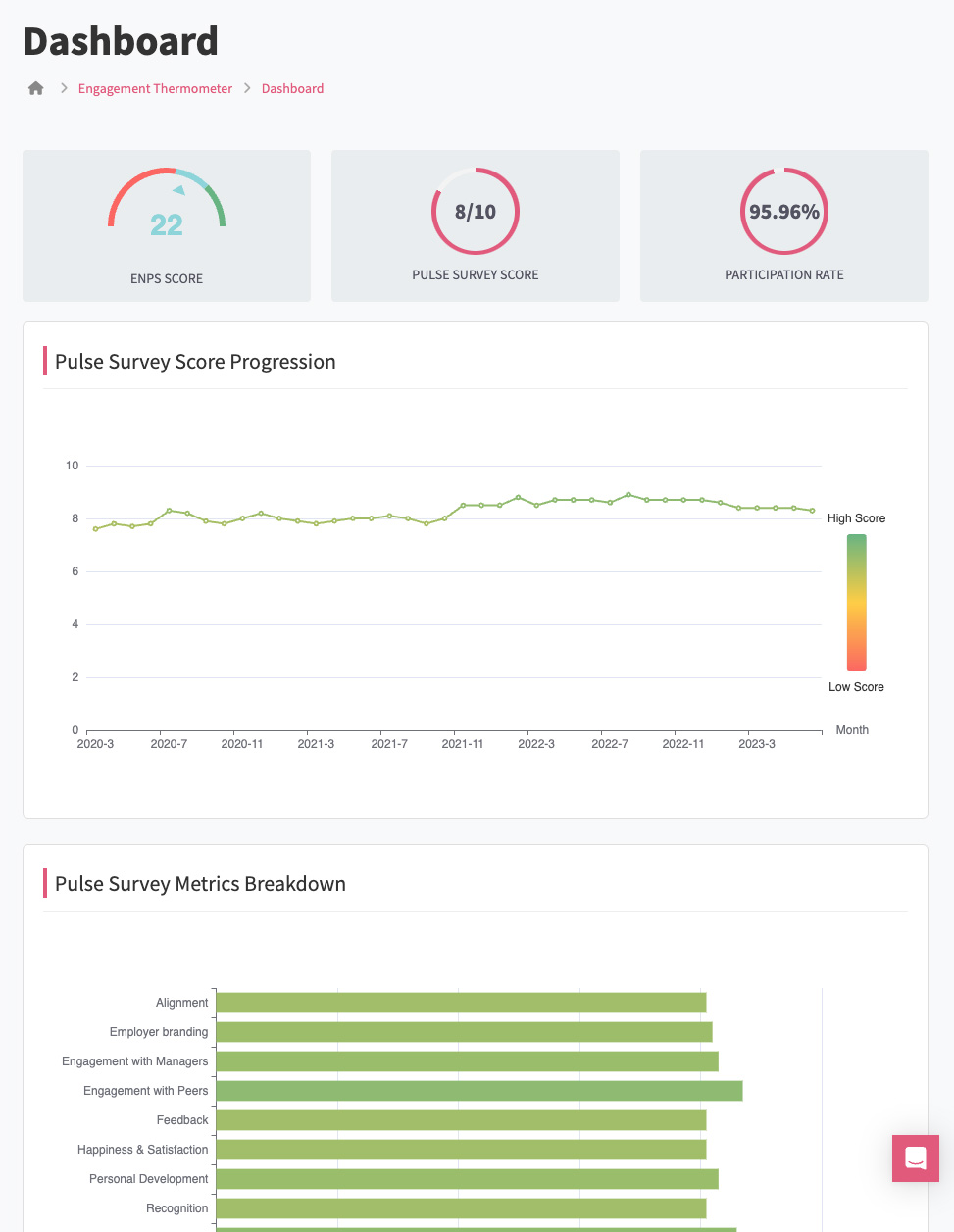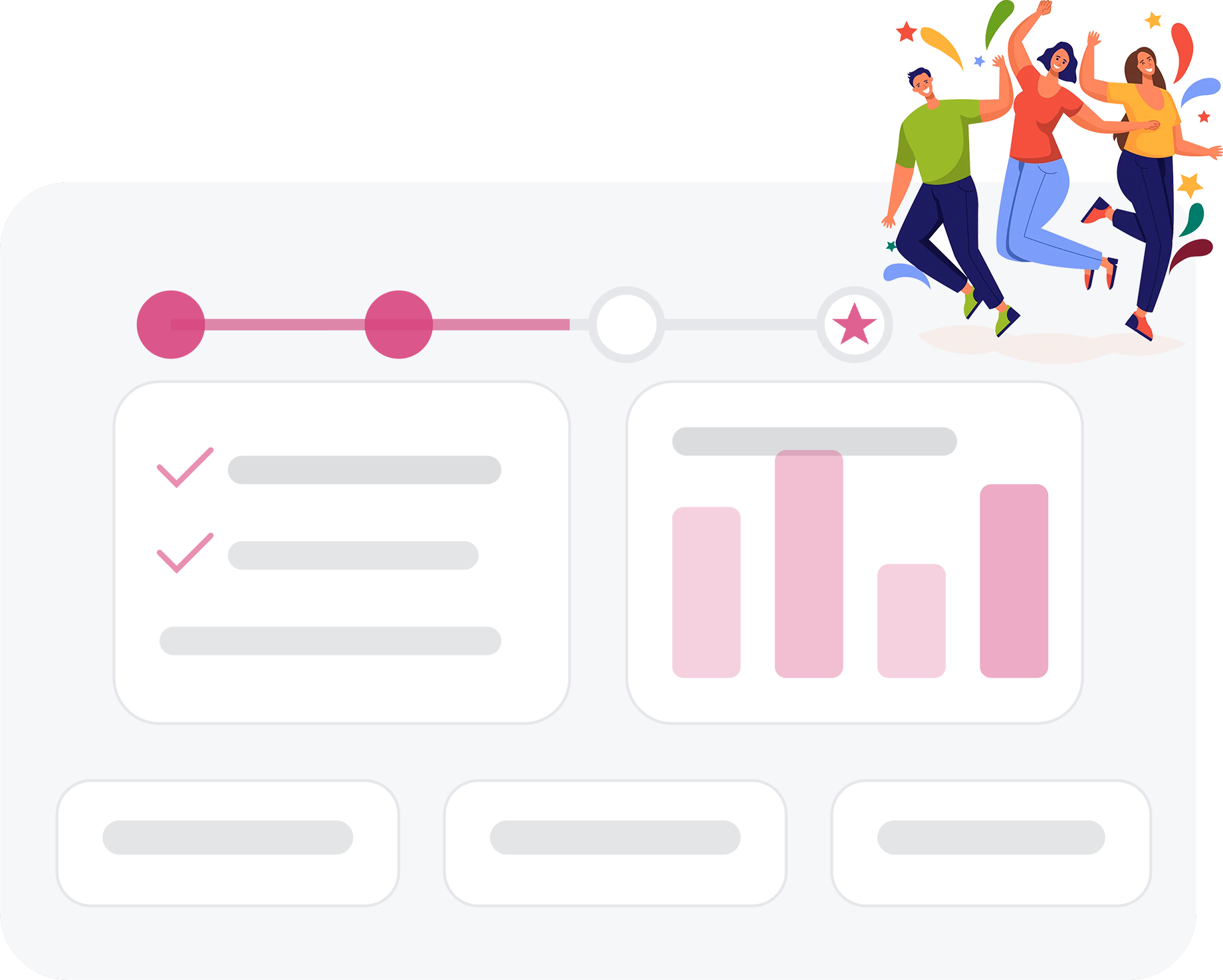 Introduction
Introduction
Employee feedback is the backbone of an effective and dynamic organization. In today’s rapidly changing business environment, the traditional annual or bi-annual surveys no longer suffice.
Enter the era of pulse surveys, a modern approach to gauging employee sentiment and organizational health.
In this guide, we will delve deep into the dual power of pulse surveys: the quantitative metrics and the qualitative emotions.
What Are Pulse Surveys?
Pulse surveys are short, periodic questionnaires designed to quickly capture employee feedback. Unlike their traditional counterparts, these surveys are frequent, concise, and aimed at addressing immediate concerns. Let’s break down their characteristics and understand their growing importance.
Definition and Characteristics
A pulse survey is typically a set of brief questions that employers send out at regular intervals to employees. The aim is to “take the pulse” or gauge the mood and engagement levels of the workforce. These surveys can range from weekly check-ins to quarterly feedback forms. Their brevity makes them easy for employees to complete, ensuring higher response rates and more accurate data.
Distinguishing Pulse Surveys from Traditional Surveys
While both pulse and traditional surveys aim to gather employee feedback, their approach and frequency differ. Here’s a quick comparison:
| Criteria | Pulse Surveys | Traditional Surveys |
|---|---|---|
| Frequency | Weekly/Monthly/Quarterly | Annually/Bi-Annually |
| Length | Short (5-15 questions) | Long (50+ questions) |
| Focus | Immediate Concerns | General Feedback |
| Response Rate | Higher | Lower due to length |
Given the immediate nature of pulse surveys, they offer actionable insights for managers and leaders. For instance, if an issue arises in a particular department, a quick pulse survey can help understand its depth and suggest immediate corrective measures.
 The Quantitative Power: Metrics in Play
The Quantitative Power: Metrics in Play
Modern organizations harness the power of data-driven decision-making. Pulse surveys, with their quantitative prowess, have become invaluable tools in this endeavor. By understanding the metrics and numbers these surveys yield, we can extract tangible insights to shape the future of our organizations.
The Science of Numbers
Data has been aptly termed as the ‘new oil.’ However, without refinement, this oil cannot fuel decision-making processes. Pulse surveys act as a refinery in this analogy, transforming raw data into actionable insights.
- The kind of data pulse surveys yield: Pulse surveys primarily produce quantitative data in the form of scaled responses, ranking preferences, and multiple-choice answers. This structured data allows for easier analysis and clear benchmarking against previous results or industry standards.
- Importance of regular intervals in data collection: Consistency in data collection is key. By gathering data at regular intervals, organizations can detect anomalies, shifts in sentiment, and incremental changes that might be overlooked in less frequent, broader surveys. The Gallup research underscores this, suggesting that real-time metrics lead to real-world improvements.
Measuring Employee Engagement
Engaged employees are the bedrock of a thriving organization. Pulse surveys, with their specific metrics, provide a magnifying lens to understand this engagement at a granular level.
Key metrics used in pulse surveys: Common metrics include job satisfaction, alignment with company values, and likelihood to recommend the organization to others. Another significant metric is the Net Promoter Score (NPS) which gauges an employee’s willingness to recommend their workplace to friends or family.
Heres a list of some common Key Metrics used in pulse surveys:
- Employee Engagement: Measurement of enthusiasm, motivation, and connection to the company’s goals.
- Job Satisfaction: Understanding how content employees are with their current roles, responsibilities, and working conditions.
- Company Alignment: Assessing whether employees understand and connect with the company’s mission, vision, and values.
- Work-Life Balance: Evaluating the balance employees have between their work responsibilities and personal lives.
- Team Collaboration and Communication: Measuring the effectiveness of teamwork and the communication flow within and across teams.
- Manager Effectiveness: Assessing how well managers are leading, supporting, and communicating with their teams.
- Career Development Opportunities: Gauging employees’ perception of opportunities for growth, learning, and career advancement within the organization.
- Organizational Climate: Monitoring the overall mood, perceptions, and attitudes within the company.
- Employee Well-being: Understanding the mental and physical well-being of employees, including stress levels.
- Feedback and Recognition: Measuring how well employees feel their contributions are recognized and how feedback is provided.
- Innovation and Creativity: Assessing the culture and environment that promotes or hinders innovation and creativity within the company.
- Diversity and Inclusion: Understanding employees’ perception of diversity, equity, and inclusion within the organization.
- Customer Focus: Evaluating employees’ understanding and alignment with customer needs and expectations.
- Technology and Tools Satisfaction: Assessing how satisfied employees are with the tools and technology provided to complete their tasks.
- Challenges and Barriers: Identifying specific challenges or barriers that might be hindering employees’ productivity or satisfaction.
How these metrics give an overview of organizational health: By collectively examining these metrics, leaders can gauge overall morale, detect departments or teams that might be struggling, and implement strategies to address specific pain points. A high job satisfaction score combined with a low alignment with company values, for instance, might indicate a misalignment between individual and organizational goals.
Tracking Over Time
The true power of pulse surveys lies not just in a singular snapshot but in the ongoing narrative they create over time.
- The significance of trend analysis: Continuous data collection allows organizations to observe patterns and trends. This trend analysis can highlight persistent challenges or validate the effectiveness of implemented strategies.
- Case study illustrating how metrics revealed a trend: a well-known tech company, after introducing flexible work hours, started to use pulse surveys to track job satisfaction. While initial results showed a spike, over the next three quarters, there was a consistent decline. This trend prompted a deeper investigation, revealing that while employees enjoyed flexibility, they missed the camaraderie of fixed office hours. This company then introduced bi-weekly in-office team days to address this sentiment, leading to a subsequent rise in satisfaction scores in the following quarters.
 The Qualitative Power: Capturing Emotions
The Qualitative Power: Capturing Emotions
While numbers and metrics offer a structured understanding of an organization’s climate, it’s the qualitative insights that give life to these numbers. Pulse surveys, with their potential to capture emotions and sentiments, act as a bridge between numerical data and the human experiences behind them.
Beyond the Numbers
Understanding employee sentiment is paramount to creating an environment where people thrive. Pulse surveys, with their unique design, can dive deep into the emotional fabric of an organization.
- How pulse surveys tap into employee sentiments: These surveys often include open-ended questions that invite employees to share their feelings, concerns, and ideas. Unlike structured queries, these responses reveal sentiments, providing a richer dimension to the feedback.
- The significance of open-ended questions: Open-ended questions in pulse surveys give employees a voice. They allow for the expression of nuanced feelings that can’t be captured by a mere numerical scale. They reveal the “why” behind the metrics, helping organizations to address root causes rather than surface symptoms.
Reading Between the Lines
Qualitative feedback, while rich, can be challenging to decipher. Advanced tools and methodologies help extract meaning from these narratives.
- Interpreting qualitative data: Sifting through qualitative feedback requires a careful understanding of context, tone, and underlying themes. Thematic analysis, for instance, can be employed to categorize responses into common themes or topics.
- Using sentiment analysis and other tools: Sentiment analysis is a potent tool that uses AI to gauge the sentiment behind a piece of text. Organizations can employ this technology to automatically sort feedback into categories like ‘positive’, ‘negative’, or ‘neutral’, making the task of analyzing large volumes of responses more manageable.
Stories from the Ground
The power of pulse surveys isn’t just in the collective data they produce but also in the individual stories they unearth. These tales can be transformative, highlighting areas of improvement or validating successful initiatives.
- Real-life quotes highlighting emotional insights: “I feel my contributions are valued here more than anywhere else I’ve worked,” shared one employee at a renowned tech firm. This sentiment, echoed by many, showcased the success of the firm’s recent recognition program.
- Case study illustrating how qualitative feedback led to organizational change: A green energy company, received consistent feedback about the lack of cross-departmental communication. One poignant comment mentioned, “I often feel we operate in silos, unaware of what our peers in other departments are achieving.” Taking this to heart, this company introduced monthly inter-departmental meetings and a shared digital platform, leading to increased collaboration and a more cohesive company culture.
 Incorporating Pulse Surveys in Your Organization
Incorporating Pulse Surveys in Your Organization
Introducing pulse surveys in your organization is more than just about collecting feedback. It’s about understanding, interpreting, and acting upon that feedback in a way that drives positive change. Here’s how to get started and make the most of this transformative tool.
Starting Off Right
Beginning with a strong foundation is essential. A well-crafted pulse survey can be the difference between gathering actionable insights and missing the mark entirely.
- Tips for designing effective pulse surveys:
- Keep them short and focused. Limit the questions to 10 or fewer to increase completion rates.
- Use a mix of quantitative and qualitative questions to capture a holistic view of employee sentiments.
- Ensure anonymity to encourage candid feedback.
- Common mistakes to avoid:
- Avoid leading or biased questions that can skew results.
- Don’t neglect follow-up. Failing to act on feedback can diminish trust in the process.
- Be wary of survey fatigue. While pulse surveys are frequent, avoid over-surveying your staff.
Analyzing the Dual Power
What “Pulse Surveys’ Dual Power” to mean?
- Quantitative Power: Pulse surveys often yield quantifiable data. Organizations can measure and track metrics over time, identifying trends or shifts in employee sentiment, engagement, or other focal areas.
- Qualitative Power: Beyond numbers, pulse surveys can capture the voice, concerns, ideas, and feelings of employees. This qualitative data provides rich insights that quantitative metrics might miss, helping leaders understand the “why” behind the numbers.
In essence, the “dual power” of pulse surveys lies in their ability to capture both measurable metrics and deeper insights simultaneously, providing a comprehensive view of an organization’s health and areas for improvement.
Once the data is collected, the challenge lies in interpretation. Harnessing the dual power of quantitative and qualitative data can provide a comprehensive view of organizational health.
- Tools and platforms for analysis: Platforms like GFoundry offer robust analytics features tailored for pulse surveys, providing both metric-based insights and sentiment analysis capabilities.
- Balancing metrics and emotions for comprehensive insights: GFoundry Pulse Survey solution offer a snapshot of the current state and a qualitative feedback provides the context. For instance, a dip in job satisfaction might be quantitatively identified, but employee comments will shed light on the reasons behind the dip, whether it’s workload, management issues, or something else entirely.
Taking Action
Data, irrespective of its depth and breadth, is of little value if not acted upon. Using the insights from pulse surveys should lead to tangible actions that resonate with employees.
- Importance of acting on the data: Employees invest time in providing feedback with the hope of seeing change. Not addressing concerns can lead to disengagement and disillusionment.
- Tips for communicating results and changes to employees:
- Be transparent. Share the findings (both positive and negative) with the team.
- Discuss action plans and timelines. If certain feedback cannot be addressed immediately, communicate the reasons.
- Engage in two-way dialogues. Hold town hall meetings or feedback sessions where employees can discuss the survey results and proposed actions.
 Future of Pulse Surveys
Future of Pulse Surveys
As the corporate landscape evolves, so does the methodology behind understanding its dynamics. Pulse surveys, at the forefront of this evolution, are rapidly integrating advanced technologies and adapting to emerging trends. Let’s explore what the future holds for these insightful tools.
Evolving Trends and Technologies in Pulse Survey Methods
The world of employee feedback is continuously evolving, driven by both technological innovation and shifts in workplace dynamics. As pulse surveys gain prominence, they too are undergoing transformative changes.
- Integration with Collaboration Platforms: With the rise of remote work and digital collaboration tools like Slack and Microsoft Teams, pulse surveys are becoming seamlessly integrated into these platforms. This allows for more immediate feedback after meetings or major announcements.
- Real-time Feedback: Traditional surveys often have a lag between response collection and results analysis. Emerging tools like GFoundry now offer real-time analytics, enabling leaders to act swiftly on pressing issues.
- Customization and Personalization: The one-size-fits-all approach is fading. Advanced survey platforms like GFoundry now allow companies to customize surveys based on departments, roles, or even individual employee experiences, ensuring relevance and increased engagement.
The Potential Impact of AI and Machine Learning in Interpreting Survey Data
Artificial Intelligence (AI) and Machine Learning (ML) have the potential to revolutionize the way organizations interpret and act on pulse survey data.
- Sentiment Analysis: AI can automatically categorize feedback into ‘positive’, ‘neutral’, or ‘negative’ sentiments. This is especially useful for analyzing large volumes of open-ended responses.
- Pattern Recognition: Machine learning algorithms can identify patterns or trends in feedback that might be missed by human analysts. For instance, recognizing a rising sentiment of dissatisfaction in a particular department before it becomes a broader issue.
- Proactive Insights: The true potential of AI lies in its predictive capabilities. In the future, AI could predict potential organizational issues or employee sentiments based on historical data, allowing leaders to be proactive rather than reactive.
- Integration with Other Data Sources: AI can integrate survey data with other organizational data (like productivity metrics, sales data, or attrition rates) to provide a holistic view of employee performance and satisfaction.
 Conclusion
Conclusion
This article opens by stressing the vital role of employee feedback and introduces pulse surveys as a powerful tool to harness this feedback. With a focus on the dual power of pulse surveys, we draw attention to both quantitative and qualitative insights that these surveys provide.
Quantitative Insights:
In the quantitative realm, the article emphasizes the importance of regular data collection and key metrics to gauge organizational health.
GFoundry’s Pulse Surveys software align perfectly with this concept by offering real-time insights into critical aspects of employee engagement through nine specific metrics.
Qualitative Insights:
On the qualitative front, we explore how pulse surveys capture employees’ emotions and sentiments.
The Engagement Thermometer: Pulse Surveys & Customized Assessments
GFoundry’s Engagement Thermometer and Customized Assessments enhance this aspect, enabling companies to ask personalized questions and dig deeper into how employees truly feel.
We want to help organizations incorporate effectively pulse surveys, discussing design, analysis, and implementation.
GFoundry’s solutions resonate with this guidance by offering actionable tips for improvement and enabling organizations to balance metrics and emotions for comprehensive insights.
Feedback and recognition
Feedback and recognition aren’t left out, either. GFoundry’s Feedback Module integrates seamlessly with the article’s focus on creating a strong feedback culture. Whether acknowledging skills or building interactive and engaging connections, GFoundry’s tools make feedback meaningful and impactful.
A future proof approach
As the article looks forward, it considers evolving trends and technologies in pulse survey methods, including the potential impact of AI. GFoundry’s innovative approach keeps pace with these future trends, offering an interactive, gamified way to approach recognition and feedback.
GFoundry’s solutions, including Pulse Surveys, Engagement Thermometer, and the Feedback Module, embody this dual power. They offer a complete way to understand, engage, and support employees. The connection between all these ideas is clear: knowing your employees better through both quantitative and qualitative insights and taking informed actions to foster a more engaged and productive workforce.
Subscribe to GFoundry Newsletter: Weekly Insights on HR’s Most Pressing Topics
Keep on reading:
- Mastering Employee Turnover: The Ultimate Guide to Retaining Talent and Boosting Productivity
- Pulse Surveys & People Engagement
- A Comprehensive Guide to the Impact, Benefits, and Future of Artificial Intelligence in HR
- Benefits of a Good Organizational Climate: Productivity and Talent Retention
- Talent management platform to boost employee engagement
- How to Choose the Right Talent Management Platform for Your Business
- How to Attract, Retain, and Develop Top Talent
- The Ultimate Guide to Remote Talent Management
- HR Trends: What Will HR Look Like in 2024?
- How to improve Employee Engagement and Performance? Your Ultimate Guide
- Employee well-being – the complete guide
- How to create Impactful Learning Journeys for Employees?
- Feedback: what it is, its importance and how to do it (complete guide)
- What is the importance of Compensation and Benefits for employees?
Ready to get started?
Take the next step and learn more about how GFoundry can help you.
